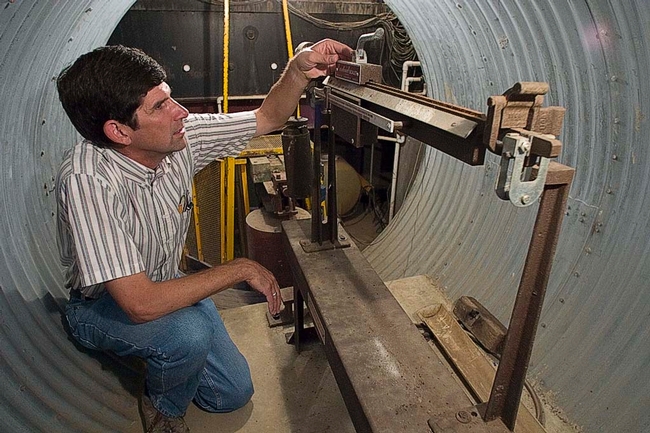
For more than a quarter century, Johnson conducted experiments with peach trees growing in the lysimeter, which allowed him to calculate precisely how much water evaporates from the soil and transpires from the tree on an hour-by-hour basis. Results of this research helped growers properly manage their irrigation strategies to improve fruit quality and yield.
A native of Utah, Johnson earned a bachelor’s degree in biology at the University of Utah. He earned a Ph.D. at Cornell in 1982 and that year moved his family to the San Joaquin Valley to begin a 31-year stint as UC Cooperative Extension specialist in the Department of Pomology at UC Davis, based at the Kearney facility in Parlier, Calif.
Using the lysimeter, Johnson discovered that some common fruit tree irrigation strategies being used in the San Joaquin Valley were significantly impacting fruit quality and yield.
“We found that growers should not cut back on water after harvest, if they can help it,” Johnson said. “Anytime we cut back on water applications, we developed some sort of problem – diseases, sunburn, mites and fruit disorders in the subsequent crops, like doubling and deep sutures.”
Despite the importance of the irrigation research, Johnson had perhaps his greatest impact on growers’ practices from his research on nitrogen fertilization. Many growers, he said, were over fertilizing their stone fruit orchards.
“We did a survey and found the average rate of nitrogen fertilization was 150 pounds per acre,” Johnson said.
However, much of that fertilizer stimulated vegetative growth, which shaded the fruit and prevented the desired reddening; and required more pruning in the winter, labor that added to the expense of growing fruit. In addition, the high fertilizer rates caused more problems with fruit quality, insect pests and diseases.
“I started working on this right at the beginning and harped on this same thing my whole career,” Johnson said. “Today, farmers are using about a half or a third of the fertilizer they did decades ago.”
Johnson also worked on understanding fruit trees’ need for other nutrients, such as zinc and calcium.
“It was pretty common for growers to apply zinc every year,” Johnson said. “From research we conducted at Kearney, we learned that orchards don’t need zinc every year. We also compared materials and found the cheapest zinc products work just as well as expensive ones. We’ve saved growers a lot of money with these results.”
Calcium research also helped farmers’ bottom line.
“Save your money,” Johnson said. “Peach trees don’t need calcium. It doesn’t help anything.”
Over the years, Johnson contributed to 70 peer-reviewed journal articles. He was an active contributor to the International Horticulture Society’s meeting proceedings, titled Acta Horticulturae, having authored or co-authored 30 articles.
Johnson worked closely with his colleagues Ted DeJong, UC Cooperative Extension specialist in the Department of Plant Sciences at UC Davis, and Kevin Day, UCCE farm advisor in Tulare County, on these and many other orchard research topics, including rootstocks, pruning, training systems, thinning, girdling, irrigation and fertilization. In 2011, Johnson took a sabbatical leave to organize and aggregate all the research findings on a comprehensive website called The Fruit Report.
“Everything is there on the website for growers establishing and managing fresh market peach, plum and nectarine orchards,” Johnson said.
Johnson has already sold his home in California and plans to move immediately back to Utah, where two of his children have settled with their families. The Johnsons will volunteer, travel, garden and, in a year, embark on a humanitarian mission with their church. Johnson has been honored with emeritus status and, though will be living out of the area, has plans to continue work on orchard fertilization management.
“There’s a great deal of interest today in reducing the potential for nitrogen to percolate down to the groundwater,” Johnson said. “You can get some nitrogen into a peach tree by spraying it on the leaves. It doesn’t get to the soil so there is less of a possibility of groundwater contamination. There may be some interest in this idea in the future, particularly in areas where the soil is very sandy or the orchard is near a stream.”
Though Johnson said he had some misgivings about working off campus when he first took the job with the University of California, he leaves with no regrets.
“I loved working at Kearney,” Johnson said. “To me, it turned out to be the ideal job.”